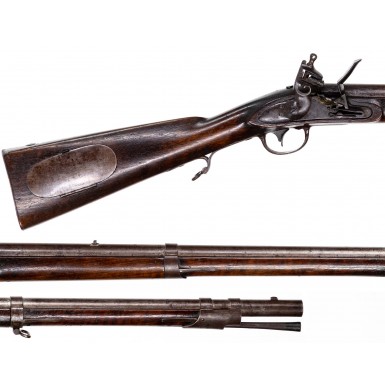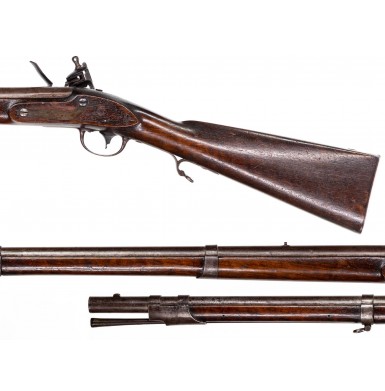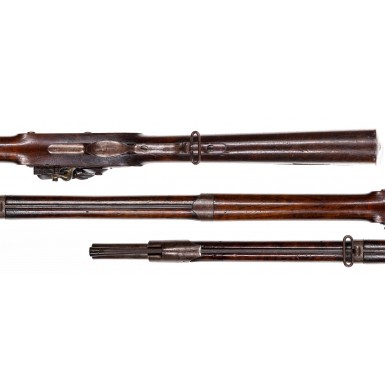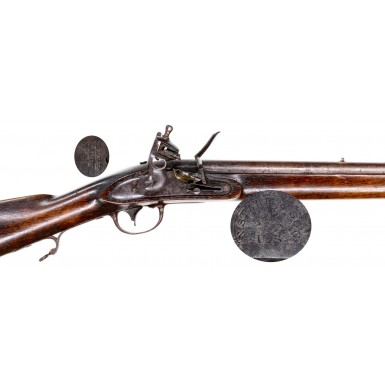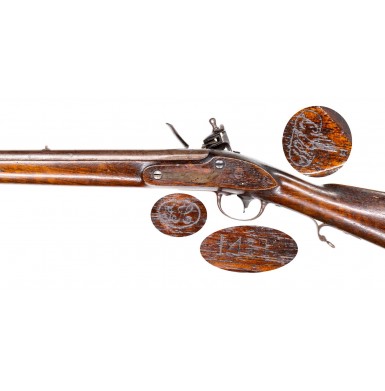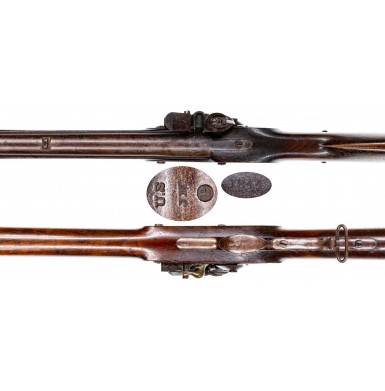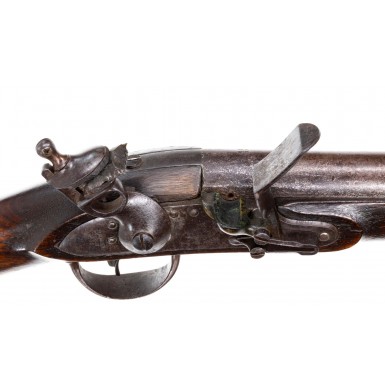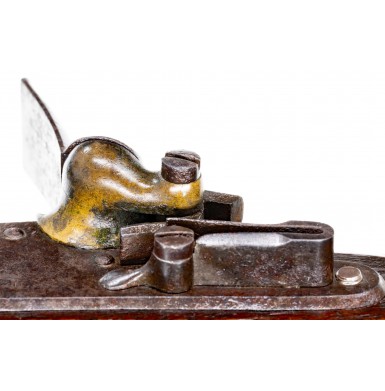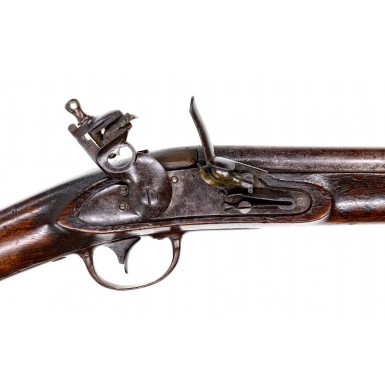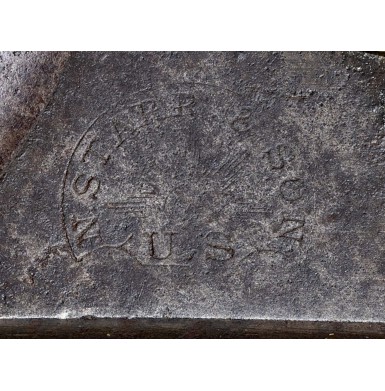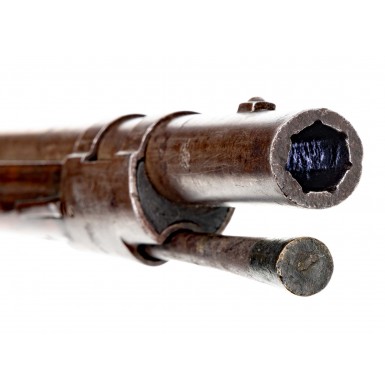Nathan Starr & Son US Contract Model 1817 Common Rifle in Original Flint
- Product Code: FLA-3832-SOLD
- Availability: Out Of Stock
-
$0.00
The US Model 1817 Common Rifle was a unique US military long arm in that it was never produced at a National Armory, other than some sample models that were made up at Harpers Ferry, with all of its production being handle by contractors. 38,267 of the rifles were produced by five different contractors between 1819 and 1845. The contractors included Henry Deringer of Philadelphia, as well as Robert Johnson, Robert & J.D. Johnson, Simeon North and Nathan Starr & Sons, the last four all being located in Middletown, CT. Deliveries by the contractors from greatest to least were as follows: Henry Deringer: 13,000, Nathan Starr: 10,000, Simeon North: 7,205, Robert Johnson: 5,002 and Robert & J.D. Johnson: 3,060. Although the rifles were adopted in 1817, it appears that in some cases the US Ordnance Department thought of the rifle as the “Model 1819”. The 1841 Ordnance Manual refers to them as “Common Rifle, Full-Stocked; 1819”, which apparently refers to the first year the rifles were delivered. Most other period sources do use the model designation “Model 1817”.
The US Model 1817 “Common” Rifle was an elegant and graceful flintlock rifle and was certainly one of the more aesthetically pleasing of the US military long arms from the first half of the 19th century. It had a 36” long, .54 caliber, round barrel, rifled with seven deep grooves with a high rate of twist for shooting a patched round ball. The barrel was secured to the stock by three spring-retained barrel bands and a single tang screw. Initially the barrels and furniture of some of the contract rifles was polished to National Armory Bright and were left unfinished. Later the metal of most of the rifles was finished with a lacquer brown. This change over appears to have happened during fiscal year 1826, meaning that those guns that had been left bright by their manufacturers initially were being browned after July 1 of 1825, when fiscal year 1826 began. This changeover can be documented by additional payments made to some of the contractors for browning the rifles. Whether the guns were delivered browned or bright, the lock was color case hardened, and the hammer and small work (screws, rear sight, etc.) were blued as part of the heat drawing process. The rifle had an oval patch box inlet into the obverse buttstock for the storage of cleaning implements and greased patches. As originally produced, the rear tang of the triggerguard extended to form a pistol grip, from which a sling swivel was suspended. Later production rifles eliminated the extended finger-rest tang and relocated the lower swivel to the more conventional location of the triggerguard’s front bow. The upper swivel was mounted on a stud below the middle barrel band. The rifle was produced with a fixed, V-notch rear sight and a front sight that was either a brass blade on the upper barrel band or a fixed blade on the barrel near the muzzle. As originally produced, the rifle did not accept a bayonet of any kind. The ramrod was a trumpet shaped iron rod with a brass tip to prevent damage to the rifling during the ramming process. The opposite end of the rammer was threaded for the attachment of implements, including a wiper, and ball puller.
The US Model 1817 Common Rifle was extremely popular during its period of use, and many of the guns were delivered to the various states under the terms of the Militia Act of 1808. The rifle saw significant use during the Seminole Wars in the south and during the Mexican American war as well. The rifles continued to serve well into the percussion age, and the National Armories, at the request of the states, altered many of these guns to percussion via the Belgian or “cone-in-barrel” system. The term “Common Rifle” was a period appellation and was used to differentiate between the “common”muzzleloading rifle and the “less common” and certainly more unique Hall’s Patent breech loading rifle. With just over 38,000 of the rifles being produced by all of the contractors, the guns are far from “common” in the greater scheme of things, when you consider that approximately 900,000 US M1816/22/28 flintlock muskets were produced during the same time frame by the National Armories and about two dozen contractors. That production ratio indicates that roughly two-dozen US M1816 muskets were produced for every M1817 rifle!
With the coming of the American Civil War, thousands of US Model 1817 rifles, many already altered to percussion, were in state armories around the country. Thousands were in the hands of the Southern states that had seceded, but many were in Northern armories as well. Extant examples exist with state ownership marking from both North and South Carolina (these markings are from the Seminole War era), as well as the state of New Jersey. Another 5,000 US M1817 Rifles were in storage at the Benicia Arsenal in San Francisco in 1861, and many of these rifles were issued to the 1st California Volunteer Cavalry, who fought in the far western theater against Confederate forces in New Mexico and Arizona. Even as late as March of 1863, “Common Rifles” were showing up in Confederate arsenal inventories. With the significant number of M1817 rifles altered to percussion during the 1850s and the early Civil War years, finding a rifle in its original flintlock configuration is very difficult. As such, these guns demand a significant premium when found in original flint condition.
The US Model 1817 Common Rifle offered here is one of the 10,000 guns produced by Nathan Starr of Middleton, CT. The firm’s first contract for the rifles was dated 9 December 1823 and was for 4,000 rifles. The first deliveries under that contract were the following year and a total of 800 guns were received by the Ordnance Department from Starr in 1824. In 1825 1,540 rifles were delivered, in 1826 1,460 and in 1827 the last 200 guns were delivered, completing the 1823 contract. The first 2,600 rifles delivered under the first Starr contract were finished bright, but the last 1,400 rifles were delivered browned, with Starr receiving additional payment over and above the original contract price for applying the finish to the arms. The next contract that the firm received was dated 17 March 1840 and was to the successor of the original firm, now doing business as Nathan Starr & Son. This contract was for 6,000 rifles which were delivered between 1840 and 1845. Per the terms of this contract all of the rifles were to be browned. Starr’s deliveries were 340 rifles in 1840, 1,660 in 1841, 1,500 in 1842, 1200 in 1843, 900 in 1844 and the last 400 were delivered in 1845. It is worth noting that the last of the flintlock Common Rifles were being delivered alongside the newly adopted percussion ignition Model 1841 “Mississippi” Rifle, which had made the Model 1817 Rifle obsolete.
This 2nd contract US Model 1817 Rifle by Nathan Starr & Sons remains in about VERY GOOD condition overall. Sadly, it retains essentially none of its lacquer browned finish but much more importantly it remains in its original flintlock configuration. It also retains a fine and crisp stock that is well marked. The lock of the rifle is stamped forward of the hammer N. STARR & SON in an arc over a rising starburst over US. The tail of the lock is stamped in three vertical lines: MIDDTN / CONN / 1843. The interior of the lock has the matching mating (or inspection) mark G on all parts, even on the outer edge of the frizzen, on the top jaw of the cock, and on the inside of the cock’s neck. The fit of the pan is perfect and there is absolutely no doubt that it is original to the lock and that the lock itself remains in its original flintlock configuration. The lock has a mostly moderately oxidized plum brown and gray patina and shows some moderate pinpricking and light pitting, along with some scattered surface oxidation. The lock markings are actually clearly visible when the gun is viewed at an angle but are very hard to read and photograph straight on. The brass flash pan has a thickly oxidized and untouched ochre patina and shows some erosion, debris and substantial staining both on its interior and exterior. The breech plug tang of the barrel is dated 1844, one year off of the lock, which is not uncommon. This suggests that this rifle was likely delivered in early 1844 as part of the 900 guns Starr delivered in that year. The barrel is also clearly marked at the breech with a US / P / JH, with the “P” raised inside a sunken oval. The initials “JH” are those of Joseph Hannis, a civilian employee of the Springfield Arsenal who worked at Springfield Arsenal from at least the fall of 1836 through most of the Civil War, until at least some time in 1864. During that time, he was not only an actual workman at the arsenal but served as a sub-inspector of contract arms. During his tenure as an inspector, he viewed thousands of arms ranging from flintlock muskets, rifles and pistols, to sabers and swords, percussion revolvers and arms as innovative as the Greene Carbine. His matching script JH cartouche is present in the forward position on the counterpane of the stock as well, in front of the script WAT of Ordnance Department officer William Anderson Thornton. Numerous small H sub-inspections are found throughout the gun, including at the tail of the counterpane, on the sideplate and on the left breech flat of the rifle. As noted, the barrel retains essentially no finish and appears to have been “struck bright” at some point in time. There are some traces of brown under the barrel, but they are thin, and it is clear that the finish was removed at some point in time. The barrel has a mottled and heavily oxidized brownish-gray patina with a dull pewter base color, other areas of darker gray and age discoloration and mottled patches of heavily oxidized discoloration and surface scale as well. The breech area shows some moderate pitting, and the touchhole shows moderate amounts of erosion but shows no signs of having been molested. The pitting thins out forward of the breech and the balance of the barrel is predominately smooth with some lightly scattered pitting, some pinpricking and some areas of surface roughness scattered along the barrel and on the bands. The bore of the rifle remains in its original .54 caliber configuration and is in about GOOD+ condition. It is dark and heavily oxidized with moderate pitting along its length, but still retains very deep, crisp rifling. The furniture retains some apparent freckled traces of the lacquer brown finish but overall has the same appearance as the barrel, with a mottled gray and brown appearance, some scattered light pitting and moderate amounts of scattered surface oxidation. The patina of the barrel and furniture match perfectly. The lock of the rifle is in excellent mechanical condition and functions crisply on all positions. As noted, the touchhole is unmolested and shows moderate oxidation and pitting. The hole is well centered in the pan and correctly angled and tapered, although slightly enlarged due to flash and burn out. The rifle retains its original V-notch rear sight, as well at its original front iron sight near the muzzle. Both original sling swivels are present, the lower one attached to the spur extension of the trigger plate and the upper swivel is located on the middle band. The original trumped head, brass-tipped 36” ramrod is present with the rifle as well and retains its original threads at the end. The exposed steel portion of the rod’s shank is lightly oxidized with some scattered discoloration. The stock of the rifle is in about FINE condition and is actually a little nicer than the metal of the gun. The stock remains solid and full-length, and is free of any breaks, major cracks or repairs. The stock shows some scattered bumps, dings and handling marks from issue and use. The stock shows no indication of having been sanded and retains crisp lines and sharp edges throughout. The flat opposite the lock has the crisp and clear script cartouches mentioned above, a JH and a WAT. The initials HM are lightly and neatly scratched into the counterpane below the cartouches and into the reverse of the butt, where they are larger. These initials certainly appear to be from the period of use, but whose they are can probably never be determined.
Overall, this is a very solid example of a US Model 1817 “Common” Rifle that remains in its original flint configuration and has an attractive, untouched appearance. The rifle was made as part of the last two contracts for these guns, a rifle that was already obsolete as it was being delivered. Despite that, this rifle clearly had an active service history and saw substantial use but was never abused or mistreated. The gun displays very nicely, has very nice wood and nice markings throughout but did not spend its life in storage. Rather it saw service, more than likely during the Mexican War or on the frontier and then during the Civil War as well. Original flintlock M1817 Rifles are getting harder and harder to find every day and this is a very nice, solid example that is 100% complete, correct and original and for which you will never have to make any excuses. This is a rifle that actually looks better in person than in the photos, as the harsh photographic lights and unforgiving eye of the lens make it look a little more worn and homely than it really is.
SOLD
Tags: Nathan, Starr, Son, US, Contract, Model, 1817, Common, Rifle, in, Original, Flint



